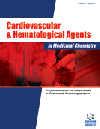- Home
- A-Z Publications
- Cardiovascular & Hematological Agents in Medicinal Chemistry (Formerly Current Medicinal Chemistry - Cardiovascular & Hematological Agents)
- Previous Issues
- Volume 8, Issue 1, 2010
Cardiovascular & Hematological Agents in Medicinal Chemistry (Formerly Current Medicinal Chemistry - Cardiovascular & Hematological Agents) - Volume 8, Issue 1, 2010
Volume 8, Issue 1, 2010
-
-
Aliskiren: A New Drug for an Old Problem
More LessAuthors: V. Barrios and C. EscobarThe renin-angiotensin-aldosterone system plays a key role in the development of hypertension-related target organ damage. Nonetheless, compensatory increases in plasma renin levels that lead to adjustments in angiotensin production and conversion limit the potential benefits of both angiotensin converting enzyme inhibitors and angiotensin receptor blockers. On the other hand, the ONTARGET trial reported that the c Read More
-
-
-
Cardiotoxicity of Tyrosine-Kinase-Targeting Drugs
More LessAuthors: A. Garcia-Alvarez, X. Garcia-Albeniz, J. Esteve, M. Rovira and X. BoschThe development of the so-called “targeted therapies”, particularly those drugs that inhibit the activity of tyrosine kinases, has become a remarkable progress in the treatment of neoplastic diseases. The small molecule tyrosine kinase inhibitor (TKI) imatinib has revolutionized the treatment of chronic myeloid leukemia, and trastuzumab, the humanized monoclonal antibody against the ERBB2 receptor tyrosine kina Read More
-
-
-
The Role of Intravascular Ultrasound to Guide Drug-Eluting Stents Implantation
More LessAuthors: T. Nakamura, J. P. Chen, D. Panchal, T. Nguyen, S. B. King III, N. Chronos and D. HouSerial IVUS has demonstrated significant differences in intimal hyperplasia (IH) volume between drug-eluting stent (DES) and bare metal stents (BMS) in recent clinical trials. It has also been reported that IVUS is a useful tool in determining optimal DES implantation, especially for diabetes mellitus (DM) patients. Recent data have also suggested a critical role for, IVUS guidance in reduction of risk for DES thrombosis. IVUS h Read More
-
-
-
Potential Approaches to Enhance the Effects of Estrogen on Senescent Blood Vessels and Postmenopausal Cardiovascular Disease
More LessBy R. A. KhalilCardiovascular disease (CVD) is more common in postmenopausal than premenopausal women, suggesting vascular protective effects of estrogen. Vascular estrogen receptors ERα, ERβ and a transmembrane estrogen-binding protein GPR30 have been described. Also, experimental studies have demonstrated vasodilator effects of estrogen on the endothelium, vascular smooth muscle and extracellular matrix. However, ran Read More
-
-
-
The Role of Vascular Endothelial Growth Factor Gene as the Genetic Marker of Atherothrombotic Disorders and in the Gene Therapy of Coronary Artery Disease
More LessBy D. PetrovicMany human diseases are characterized by vasculature disorders. Out of the many players in the angiogenic network, the vascular endothelial growth genes are by far the best characterized. The vascular endothelial growth factor (VEGF) has been implicated in the pathogenesis of coronary artery disease (CAD) and in its complication, the acute myocardial infarction (AMI). Several common polymorphisms in the promoter reg Read More
-
-
-
Cancer Treatment-Induced Cardiotoxicity: a Cardiac Stem Cell Disease?
More LessAuthors: L. Prezioso, S. Tanzi, F. Galaverna, C. Frati, B. Testa, M. Savi, G. Graiani, C. Lagrasta, S. Cavalli, S. Galati, D. Madeddu, E. L. Rizzini, F. Ferraro, E. Musso, D. Stilli, K. Urbanek, E. Piegari, A. De Angelis, A. Maseri, F. Rossi, E. Quaini and F. QuainiCardiovascular diseases and cancer represent respectively the first and second cause of death in industrialized countries. These two conditions may become synergistic when cardiovascular complications of anti-cancer therapy are considered. More than 70% of childhood and 50% of adult cancer patients can be cured, however this important success obtained by the biological and medical research is obfuscated by emergin Read More
-
-
-
Endothelial TRPC3/6/7 Proteins at the Edge of Cardiovascular Disease
More LessAuthors: J. Y. Tano, K. Smedlund and G. VazquezAn impressive amount of experimental evidence accumulated over the last two decades has clearly demonstrated that Ca2+ influx through plasma membrane Ca2+-permeable channels plays a critical role in endothelial cell physiology and pathophysiology. Research efforts aimed at understanding the role of Ca2+ influx within the signaling events underlying endothelial dysfunction have grown at a fast pace over mor Read More
-
Volumes & issues
-
Volume 23 (2025)
-
Volume 22 (2024)
-
Volume 21 (2023)
-
Volume 20 (2022)
-
Volume 19 (2021)
-
Volume 18 (2020)
-
Volume 2 (2020)
-
Volume 17 (2019)
-
Volume 16 (2018)
-
Volume 15 (2017)
-
Volume 14 (2016)
-
Volume 13 (2015)
-
Volume 12 (2014)
-
Volume 11 (2013)
-
Volume 10 (2012)
-
Volume 9 (2011)
-
Volume 8 (2010)
-
Volume 7 (2009)
-
Volume 6 (2008)
-
Volume 5 (2007)
-
Volume 4 (2006)
Most Read This Month
Article
content/journals/chamc
Journal
10
5
false
en


